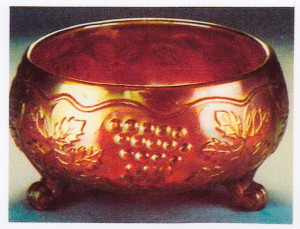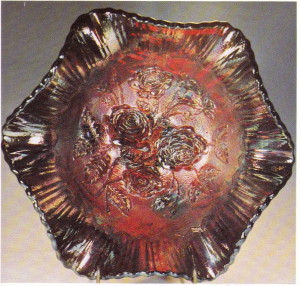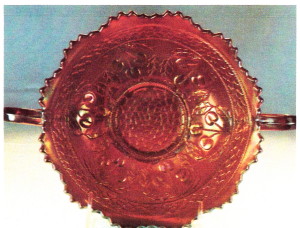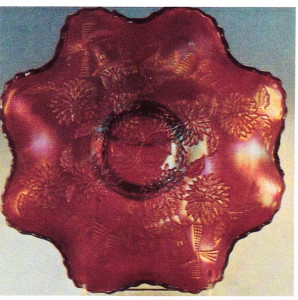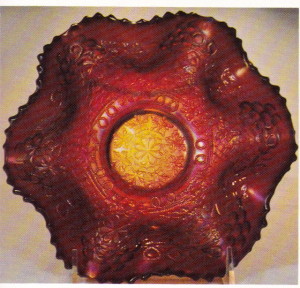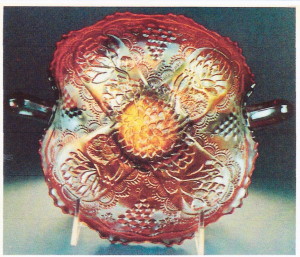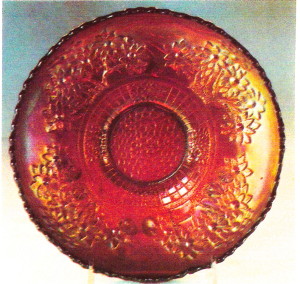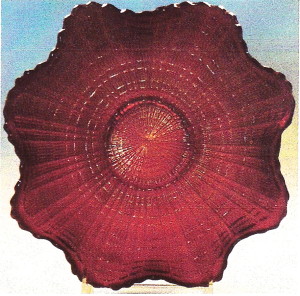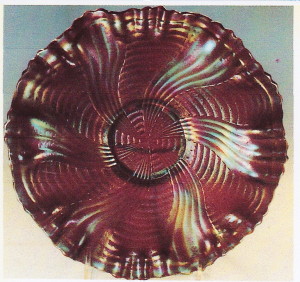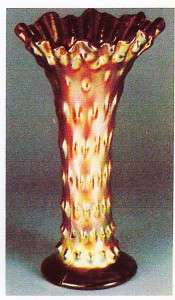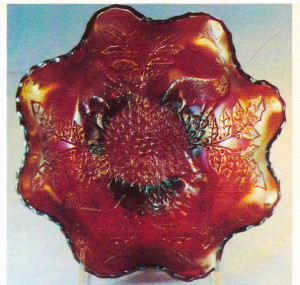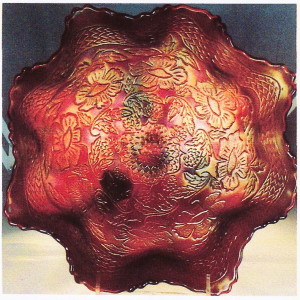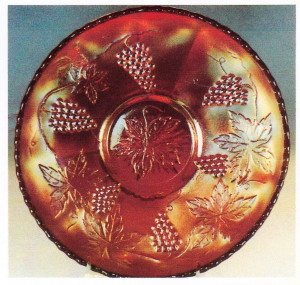by Don Moore
Please bear in mind that this article was written many years ago – December 1986. If prices are given, the prices will reflect when this was written.
The ambition of most carnival collectors is to own a piece or two of red. This isn’t always easy. The first problem is to find a piece and the next is to pay for it. I get calls from collectors who have never even seen a piece of red. We had collected for at least six or eight months before we had a chance to buy a piece at an antique show. It was a Dragon and Lotus bowl – priced at $125. We thought it over for a long time before taking the plunge. Collectors today will have to pay $650 to $750 for that same piece.
Red is a tough color to make. If the chemicals in the mix aren’t accurate or the furnace heat is wrong, out comes a lousy piece of red. Just as Northwood is associated with the pastels and Dugan with peach opal, Fenton was truly the king of red carnival. Imperial contributed a few pieces but Fenton, with few exceptions, made the rest of the red carnival. There is no evidence, to date, that Cambridge, Northwood, Millersburg, Westmoreland, Dugan/Diamond or U.S. Glass made any at all. The only possible exception are the carnival lamps that were made in four different patterns.
The makers of these lamps are unknown. They really belong in a separate category anyway as the color, on at least some of these, comes from the red spray on the interior of the globes. The iridescence is sprayed on the outside of the otherwise clear glass. The four known red lamps are:
Regal Iris Gone-with-the-Wind (one known)
Sunken Hollyhock Gone-with-the-Wind (2 known)
Roses and Ruffles Gone-with-the-Wind (3 known)
Peacock Lamp (perhaps a dozen or more)
Is It Red?
Before we go any further, let’s examine the dilemma of all new collectors – what is red carnival? First some generalities that should serve you well. If you have any doubts as to whether or not it is red, it probably isn’t. If you have trouble forcing light through the glass, it is in all likelihood a fiery amethyst or purple and not red. There are also, of course, pieces of true red that carry heavy iridescence and may not appear red when sitting on a shelf. When held to any kind of light, however, it is immediately obvious that the base color is red. This isn’t a problem when a clear iridescent spray was used as there is never any doubt on these pieces. It is only when a dark spray was used that we even have to hold such a piece to the light to know it is red. (Some Horses Heads pieces and the Fenton Peacock and Urn bowls and compotes are good examples.)
I’m sure most of us would prefer that a piece be cherry red with no hint of yellow. Remember, however, that the reddest of pieces will usually show a trace of yellow in the base or on the edges. Don’t let this worry you. It is still red carnival. Also remember that not all red is cherry red. I guess no color in the carnival spectrum will vary more than red. Some pieces will tilt toward amberina (more yellow) while others will tend toward a “brick” red (brownish). Examples of pieces that are often found in these “weaker” reds are the Sailboat sauce. Vintage nut bowls, Panther small berry bowls, and the Fenton’s Flowers rose bowl. These still qualify as red, however, and will bring red prices but it is usually true that the closer we get to cherry red, the higher the price.
Red Stretch Glass
At this point, we should deal with the matter of stretch glass as both Fenton and Imperial made a wide range of red stretch. This includes Fenton’s Florentine line of bowls in almost every shape including punch bowls, orange bowls, vases, the Dolphin pieces, covered candy dishes, candlesticks (many, including Cut Ovals), plates, etc. It also includes Imperial’s so called “Colonial” water set, candlesticks, and sugar and creamer, as well as their Floral and Optic pieces, and the the Double Scroll console set. These pieces are all rare and highly desirable, but it is my feeling they belong in a separate category, and consequently, I have not included them in my red carnival listings. Where you come down o this issue depends on your definition of “carnival”. I prefer the one that requires it to be “pressed, iridized, pattern glass, etc. While some pieces of carnival may be stretchy, stretch glass is not patterned, at least in the common sense of the the word.
Red Carnival Listings
After all that, let’s now list the pieces made by the two companies that produced red carnival – Imperial and Fenton.
Luster Rose Orange Bowl
Imperial won’t take long:
Luster Rose orange bowl
Fashion punch bowl, base, and cup
American Beauty Rose vase
Flaming Poppy vase
Latticed Grape vase
The three vases listed here are all similar. They stand about six inches high and all carry a lattice background. The glass is thick and they have a rimmed lip as though they may have been used as a container of some type. The base color is a good strong red but the iridescence is on the dull side. The Floral and Grape designs appear on one side of the vase. These are rare and very seldom seen.
And now for the Fenton:
Cherry Circles Bonbon
Acorn – 7 1/2” bowl
Blackberry (Open Edge, Blackberry interior) various basket and hat shapes (all from the same mold)
Blackberry Spray – various basket and hat shapes (all from the same mold)
Butterfly and Berry – sauce and vase
Cherry Circles (not Cherry Chain) bonbons
Chrysanthemum – collar base 9 inch bowl
Coin Dot – 7 1/2” bowl
Dragon and Lotus 9” bowl
Fenton’s Flowers – Rose Bowl
Fenton’s Open Edge Basketweave (plain interior) various basket and hat shapes (all from the same mold
Fern Panels – hat shape
Fine Rib – various size vases
Grape and Cable (Fenton’s) 6 1/2” collar base bowl, 8” ball footed bowl
Holly – 9” bowl, 9 1/2” plate, various hat shapes, sherbet (also ruffled into a compote)
Horses Head – 7” collar base bowls in various shapes, 7” ball footed bowl in various shapes (including nut bowl, but I’m not sure about rose bowl)
Leaf Chain 6″ Bowl
Leaf Chain – 7” bowl
Little Flowers – 10” bowl
Lotus and Grape Bonbon
Lotus and Grape – bonbon
Orange Tree – 9” bowl , mugs (2 sizes)
Panther – 5 1/2” berry bowl
Peacock and Grape – 9” collar base bowl, 8 1/2” spatula footed bowl
Peacock and Urn (Fenton’s) – 9” bowl, compote
Peacock Tail – 6” bowl
Persian Medallion – 9” bowl, 5” bowl, bonbon
Plaid – 9” bowl (Photo 4)
Plume Panels – vase
Plaid 9″ Bowl
Ribbon Tie – 9” ruffled low bowl
Ribbon Tie Low 3-in-one Bowl
Rustic – 8 1/2” vase
Rustic Vase
Sailboats – 5 1/2” sauce
Stag and Holly – 7 1/2” spatula footed bowl
Stag and Holly Spatula Ftd. Bowl
Stippled Rays (Fenton’s) – 6” sauce, 6 1/2” platle, bonbon, individual sugar and creamer
Strawberry (Fenton’s) – bonbon
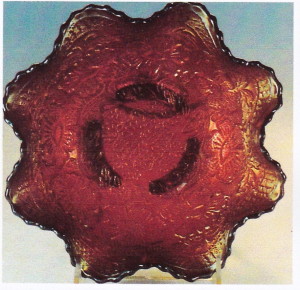 Two Flowers Spatula Ftd. Bowl – above
Two Flowers Spatula Ftd. Bowl – above
Two Flowers 10″ Bowl – below
Two Flowers – 7 1/2” spatula footed bowl , 10 1/2” ball footed bowl
Two Flowers – 7 1/2” spatula footed bowl , 10 1/2” ball footed bowl
Vintage – 6”, 9”, 10” bowls
Waterlily – 5 1/2” berry bowl
Wide Panel – Vase (This is really a non-patterned Butterfly and Berry vase)
The following pieces have been reported or rumored. My hometown in Southern Iowa was only a few miles from the Missouri state line. Maybe some of the philosophy of the “Show Me” state rubbed off on me. In any event, I would have to see these pieces before confirming their existence.
Autumn Acorn bowl – I feel this has been confused with the Acorn bowl
2 Cherry Chain or Cherry Circles bowl
Chrysanthemum large ball footed bowl
Dragon and Lotus plate
Panther master berry bowl
6 Pulled Loop vase – I wonder if this hasn’t been confused with Plume Panels
Scroll Embossed bowl – maybe, but I can’t confirm
Stag and Holly large ball footed bowl
In conclusion, I would simply reiterate that the supply of red carnival is very limited. It is a beautiful, prestigious color with an aura about it that tends to put it in a class of its own. The price has always been high, but I suspect that what we feel is “out of sight” today, may seem reasonable to the collector of tomorrow.

